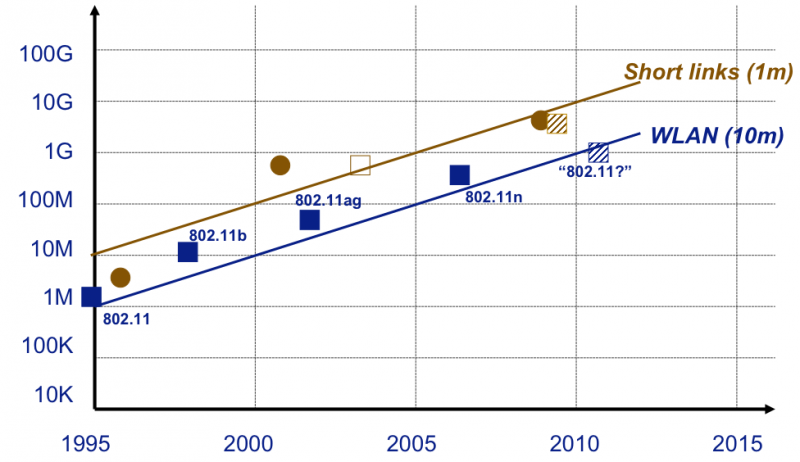Difference between revisions of "D3-WLAN Systems"
Josef.Noll (Talk | contribs) m (Josef.Noll moved page D3 to D3-Local Systems) |
Josef.Noll (Talk | contribs) (→⌘ WLAN standard IEEE_802.11) |
||
| (5 intermediate revisions by the same user not shown) | |||
| Line 1: | Line 1: | ||
| + | Keywords: [[Keywords::WLAN]], [[Keywords::Wifi]], [[Keywords::IEEE 802.11]], | ||
| + | =⌘ WLAN standard IEEE_802.11 = | ||
| + | {{:IEEE_802.11}} | ||
| − | = "WLAN communication"= | + | =⌘ Earlier Presentations on WLAN systems = |
| + | |||
| + | Susana Rodriguez de Novoa: | ||
| + | * [[Media:UNIK4700-Wlan.pdf]] | ||
| + | * [[Media:An_Introduction_to_wifi.pdf]] | ||
| + | * [[Media:radiomobile.pdf]] | ||
| + | * [[Media:WLANSecurity.pdf]] | ||
| + | * Book: Antennas and Propagation for Wireless Communication Systems. 2nd Edition | ||
| + | * Book: CCNA Wireless. Oficial Exam Certification Guide | ||
| + | |||
| + | =⌘"WLAN communication" 802.11= | ||
[[File:FettweisRadioDevelopment-WLAN.png|800px]] | [[File:FettweisRadioDevelopment-WLAN.png|800px]] | ||
<span scaled="60%>[Presentation G. Fettweis, IEEE VTC forum Baltimore], http://www.ieeevtc.org/plenaries/vtc2007fall/28.pdf </span> | <span scaled="60%>[Presentation G. Fettweis, IEEE VTC forum Baltimore], http://www.ieeevtc.org/plenaries/vtc2007fall/28.pdf </span> | ||
| + | |||
| + | =⌘ 802.11 ad standard = | ||
| + | {| | ||
| + | * addresses 60 GHz communications, 5.7 GHz available bandwidth | ||
| + | * Wavelength <math> \lambda = 0.5 </math> mm | ||
| + | * antenna on chip | ||
| + | |||
| + | Application areas: | ||
| + | * set-top boxes, TV, high-bandwidth cable replacement | ||
| + | * direct backbone links | ||
| + | * industrial construction area | ||
| + | * communications in public places | ||
| + | |- | ||
| + | Conclusions from NY University, [http://www.spectrum2020.ca/presentations/Rappaport.pdf] | ||
| + | * Measurements at 38 and 60 GHz show that NLOS links can be made with steerable antennas, with 20 – 30 dB loss compared to free space line-of-sight. | ||
| + | * A link was always made using steerable antennas within a 200 m cell radius. | ||
| + | * 38 GHz showed more NLOS links than 60 GHz | ||
| + | * Cellular AOA distributions show BS should be deployed site-specifically (due to shadowing of buildings) | ||
| + | * Worst RMS delay spread link was 122ns, similar for peer- to-peer and cellular | ||
| + | |||
| + | Further reading | ||
| + | |||
| + | * Measurements of 60 GHz http://www.sciencedirect.com/science/article/pii/S2405959515300187 | ||
| + | * 802.11ad explained http://cp.literature.agilent.com/litweb/pdf/5990-9697EN.pdf | ||
| + | |} | ||
Latest revision as of 21:04, 19 January 2016
| Wiki for ITS | ||||||
|---|---|---|---|---|---|---|
|
Keywords: WLAN, Wifi, IEEE 802.11,
Contents
⌘ WLAN standard IEEE_802.11
The newest member in the 802.11 family are the 802.11ac and the 802.11u standards
IEEE 802.11ac
802.11ac is introduced to operate in the 5 GHz band, and has, according to the Cisco White Paper, the following features:
- More channel bonding, increased from the maximum of 40 MHz in 802.11n, and now up to 80 or even 160 MHz (for 117% or 333% speed-ups, respectively)
- Denser modulation, now using 256 quadrature amplitude modulation (QAM), up from 802.11n's 64QAM (for a 33% speed burst at shorter, yet still usable, ranges)
- More multiple input, multiple output (MIMO). Whereas 802.11n stopped at four spatial streams, 802.11ac goes all the way to eight (for another 100% speed-up).
Second-generation products should also come with a new technology, multiuser MIMO (MU-MIMO). Whereas 802.11n is like an Ethernet hub that can only transfer a single frame at a time to all its ports, MU-MIMO allows an AP to send multiple frames to multiple clients at the same time over the same frequency spectrum.
IEEE 802.11u
802.11u is a new interworking standard, and allows users to connects to access points, based on their relations to other Wifi providers. As an example: A user of "UiO" may connect to "UNIK" based on the 802.11u agreement between UiO and UNIK.
References
[Source:Cisco White Paper "801.11ac: The Fifth Generation of WiFi]
Keyword D3-WLAN Systems
| D3-WLAN Systems | |
|---|---|
| Wikipedia | http://es.wikipedia.org/wiki/IEEE_802.11 |
| Related keywords | |
| All pages containing keywords | |
(edit page)
{{{ItemText}}}
Contains pages with keyword "D3-WLAN Systems".
Related information
⌘ Earlier Presentations on WLAN systems
Susana Rodriguez de Novoa:
- Media:UNIK4700-Wlan.pdf
- Media:An_Introduction_to_wifi.pdf
- Media:radiomobile.pdf
- Media:WLANSecurity.pdf
- Book: Antennas and Propagation for Wireless Communication Systems. 2nd Edition
- Book: CCNA Wireless. Oficial Exam Certification Guide
⌘"WLAN communication" 802.11
[Presentation G. Fettweis, IEEE VTC forum Baltimore], http://www.ieeevtc.org/plenaries/vtc2007fall/28.pdf
